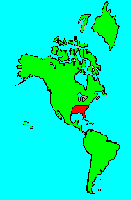SPECIES INFO
Meningitis (Naegleria fowleri) is a very deadly disease caused by an amoebae that is found in warm fresh water. It can attack swimmers by entering the nasal area, and proceed to the brain where it can be deadly. Between 2001 and 2010 about 32 cases were documented. In the summer of 2011 there have been several cases in the south eastern United States. One deadly case was from Florida and another from Virginia.Members of this group are like globs of jelly that have a free form shape.
Amoeboid Group (Sarcodina) (Rhizopoda-Actinopoda, or Sarcodina) contains the familiar Amoeba studied in elementary biology. There are probably over 200 species of amoeba-like animals which vary greatly in size. The largest ones, although still very small, can be viewed with the naked eye. A one thousand power microscope is required to view some of the very tiny species. These animals extend a foot or pseudopod for locomotion.
Protista kingdom (sometimes spelled as Protoctista) contains numerous phyla including unicellular animals and algae. Generally, these are aquatic life forms. The number of species is difficult to estimate, and it might be as low as 60,000 and as high as 200,000.
There is discussion among scientists as to whether this group of lifeforms should be split into two different kingdoms. One for those that make their own food, and the other for those that eat food. They suggest: Chromista and Protozoa.
Although herein we follow conventional norms and recognize 9 phyla, it has been suggested there might be 50 different phyla herein. These lifeforms have been found as far back as 1.2 billion years ago.

